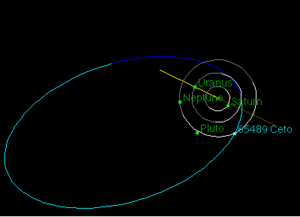65489 Ceto
|
Orbit (top view) | |
| Discovery and designation | |
|---|---|
| Discovered by | C. A. Trujillo and M. Brown |
| Discovery site | Palomar |
| Discovery date | March 22, 2003 |
| Designations | |
| MPC designation | 65489 |
Named after | Ceto |
| 2003 FX128 | |
|
TNO Centaur–extended[1] | |
| Adjectives | Cetoean |
| Orbital characteristics[2] | |
| Epoch 2455200.5 (2010-Jan-04.0) | |
| Aphelion | 181.90 AU |
| Perihelion | 17.8125 AU |
| 99.86 AU | |
| Eccentricity | 0.8216 |
| 998 years | |
| 7.384° | |
| Inclination | 22.3229° |
| 172.0572° | |
| 319.594° | |
| Known satellites |
Phorcys (171±10[3] ~ 132+6 −14 km[4] in diameter) |
| Physical characteristics | |
| Dimensions |
223±10 km[3] 174+16 −18 km[4] |
| Mass | (5.4±0.4)×1018 kg (system)[4] |
Mean density | 1.37 g/cm3 (system)[4] |
Equatorial surface gravity | 3.3 cm/s2[4] |
|
0.056±0.006[3] 0.084±0.02[4] | |
| 6.2[2] | |
|
| |
65489 Ceto /ˈsiːtoʊ/ is a binary trans-Neptunian object (TNO) discovered on March 22, 2003 by C. A. Trujillo and M. Brown at Palomar. It is named after the sea goddess Ceto from Greek mythology. The object was identified as a binary on April 11, 2006 by K. Noll, H. Levison, W. Grundy and D. Stephens using the Hubble Space Telescope; the companion object is named Phorcys (/ˈfɔərsɨs/, formally (65849) Ceto I Phorcys), after the Greek sea god. Using an extended definition of a centaur as an object on a non-resonant (unstable) orbit with its perihelion inside the orbit of Neptune,[5]the Ceto system can be considered the second known binary centaur.[4] It came to perihelion in 1989.[2]
Physical characteristics
65489 Ceto is an example of a close binary TNO system in which the components are of similar size. Combined observations with the infrared Spitzer Space Telescope and the Hubble Telescope allow the diameter of Ceto itself to be estimated at 174+16
−18 km and the diameter of Phorcys at 132+6
−14 km, assuming equal albedo for both components.[4]
The binary nature of Ceto enables direct calculation of the system mass, allowing estimation of the masses of the components and providing additional constraints on their composition. The estimated density of Ceto is 1.37+0.66
−0.32 g/cm3, significantly less than that of the large TNOs (Haumea: 3.0 g/cm3, Eris: 2.26, Pluto: 2.03, Charon: 1.65) but significantly more than that of smaller TNOs (e.g. 0.7 g/cm3 for (26308) 1998 SM165). Phorcys has a mass of about 1.67×1018 kg.[4] Unless the bodies are porous, the density is consistent with rock–ice composition, with rock content around 50%.[4]
It has been suggested that tidal forces, together with other potential heat sources (e.g. collisions or 26Al decay) might have raised the temperature sufficiently to crystallise amorphous ice and reduce the void space inside the object. The same tidal forces could be responsible for the quasi-circular orbits of the components of Ceto.[4]
References
- ↑ Marc W. Buie (2006-05-05). "Orbit Fit and Astrometric record for 65489". SwRI (Space Science Department). Retrieved 2009-01-25.
- ↑ 2.0 2.1 2.2 "JPL Small-Body Database Browser: 65489 Ceto (2003 FX128)" (2006-05-05 last obs). Retrieved 2009-12-12.
- ↑ 3.0 3.1 3.2 Santos-Sanz, P., Lellouch, E., Fornasier, S., Kiss, C., Pal, A., Müller, T. G., Vilenius, E., Stansberry, J., Mommert, M., Delsanti, A., Mueller, M., Peixinho, N., Henry, F., Ortiz, J. L., Thirouin, A., Protopapa, S., Duffard, R., Szalai, N., Lim, T., Ejeta, C., Hartogh, P., Harris, A. W., & Rengel, M. (2012). “TNOs are Cool”: A Survey of the Transneptunian Region IV - Size/albedo characterization of 15 scattered disk and detached objects observed with Herschel Space Observatory-PACS
- ↑ 4.0 4.1 4.2 4.3 4.4 4.5 4.6 4.7 4.8 4.9 4.10 Grundy, W.M.; Stansberry, J.A.; Noll K.S.; Stephens, D.C. et al. (2007). "The orbit, mass, size, albedo, and density of (65489) Ceto/Phorcys: A tidally-evolved binary Centaur". Icarus 191: 286. arXiv:0704.1523. Bibcode:2007Icar..191..286G. doi:10.1016/j.icarus.2007.04.004.
- ↑ J. L. Elliot; S. D. Kern; K. B. Clancy; A. A. S. Gulbis; R. L. Millis; M. W. Buie; L. H. Wasserman; E. I. Chiang; A. B. Jordan; D. E. Trilling & K. J. Meech (February 2005). "The Deep Ecliptic Survey: A Search for Kuiper Belt Objects and Centaurs. II. Dynamical Classification, the Kuiper Belt Plane, and the Core Population." (PDF). The Astronomical Journal 129: 1117. Bibcode:2005AJ....129.1117E. doi:10.1086/427395.
Wiki links
External links
- Orbital simulation from JPL (Java) Horizons Ephemeris
- Binary asteroids at johnstonsarchive
| ||||||
| ||||||||||||||||||||||||||||
